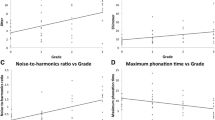Abstract
Background/objective
The aim of this study is to estimate the effect of voice therapy intervention in adults with vocal fold nodules, on three acoustic voice parameters (fundamental frequency, jitter and shimmer). The purpose of this meta-analysis is to present evidence based on literature regarding objective acoustic voice parameters changes, after voice therapy, in patients with bilateral VFNs. A pooled statistical analysis comparing pre- and post-therapy measurements of three acoustic voice parameters (average F0, % jitter and % shimmer) were performed.
Methods
A literature review was performed by searching studies in adults, with bilateral vocal fold nodules who received voice therapy, and where voice quality was evaluated quantitatively using acoustic analysis, before and after treatment. Meta-analysis was performed using random-effects model. PubMed, CINAHL, CENTRAL and Web of Science were searched for retrospective and prospective cohort, cross-sectional and case–control with comparative studies in adults published between January/1995 and March/2019 and English written. Search terms used were: intervention, therapy, vocal, voice, nodules, bilateral, multidimensional assessment, acoustic and analysis.
Results
Overall 1950 articles were identified. After removing repeated articles and conducting screening stages using inclusion and exclusion criteria, a total of four studies were selected with 147 participants for the meta-analysis. The pooled results analysis showed a statistically significant effect in two acoustic parameters after voice therapy: (1) F0 [increased mean difference post-therapy was 33.00 Hz (95% CI 20.26–45.74, p < 0.001)] and (2) jitter (%) [decreased mean difference post-therapy was 0.59% (95% CI 0.23–0.94%, p = 0.001)]. In addition, a non-statistically significant effect in shimmer (%) [decreased mean difference post-therapy was 2.98% (95% CI − 0.03–6.00, p = 0.052)].
Conclusion
Acoustic analysis has a clinical role in patients with vocal fold nodules, by objectively assessing and providing data on the effect of voice therapy in voice acoustic parameters. This meta-analysis has shown that patients with vocal fold nodules improved their acoustic voice parameters after receiving voice therapy.



Similar content being viewed by others
References
Verdolini K, Rosen CA, Branski RC (2014) Classification manual for voice disorders-I. Psychology Press, London
Martins RHG, Defaveri J, Domingues MAC, de Silva RD (2011) Vocal polyps: clinical, morphological, and immunohistochemical aspects. J Voice 25:98–106
Johns MM (2003) Update on the etiology, diagnosis, and treatment of vocal fold nodules, polyps, and cysts. Curr Opin Otolaryngol Head Neck Surg 11:456–461
Holmberg EB, Doyle P, Perkell JS et al (2003) Aerodynamic and acoustic voice measurements of patients with vocal nodules: variation in baseline and changes across voice therapy. J Voice 17:269–282
Hsiung M-W, Hsiao Y-C (2004) The characteristic features of muscle tension dysphonia before and after surgery in benign lesions of the vocal fold. ORL 66:246–254
Hogikyan ND, Appel S, Guinn LW, Haxer MJ (1999) Vocal fold nodules in adult singers: regional opinions about etiologic factors, career impact, and treatment. A survey of otolaryngologists, speech pathologists, and teachers of singing. J Voice 13:128–142
Dikkers FG, Nikkels PGJ (1999) Lamina propria of the mucosa of benign lesions of the vocal folds. Laryngoscope 109:1684–1689
Dejonckere PH (2000) Clinical implementation of a multidimensional basic protocol for assessing functional results of voice therapy. A preliminary study. Rev Laryngol 121:311–313
Hillenbrand JM (2011) Acoustic analysis of voice: a tutorial. Perspect Speech Sci Orofac Disord 21:31–43
Hirano M, Hibi S, Yoshida T et al (1988) Acoustic analysis of pathological voice: some results of clinical application. Acta Otolaryngol 105:432–438
Lieberman P, Laitman JT, Reidenberg JS, Gannon PJ (1992) The anatomy, physiology, acoustics and perception of speech: essential elements in analysis of the evolution of human speech. J Hum Evol 23:447–467
Vaz-Freitas S, Pestana PM, Almeida V, Ferreira A (2018) Acoustic analysis of voice signal: comparison of four applications software. Biomed Signal Process Control 40:318–323
Moher D, Shamseer L, Clarke M et al (2015) Preferred reporting items for systematic review and meta-analysis protocols (PRISMA-P) 2015 statement. Syst Rev 4:1
Zaugg H, West RE, Tateishi I, Randall DL (2011) Mendeley: creating communities of scholarly inquiry through research collaboration. TechTrends 55:32–36
Chhetri SS, Gautam R (2015) Acoustic analysis before and after voice therapy for laryngeal pathology. Kathmandu Univ Med J (KUMJ) 13:323–327
Glasziou PP, Irwig L, Bain CJ, Colditz GA (2000) How to review the evidence: systematic identification and review of the scientific literature. Handbook series on preparing clinical practice guidelines.
Ripley BD (2001) The R project in statistical computing. MSOR Connect Newsl LTSN Maths Stats OR Netw 1:23–25
Sterne JAC, Egger M (2001) Funnel plots for detecting bias in meta-analysis: guidelines on choice of axis. J Clin Epidemiol 54:1046–1055
Fu S, Theodoros DG, Ward EC (2015) Delivery of intensive voice therapy for vocal fold nodules via telepractice: a pilot feasibility and efficacy study. J Voice 29:696–706. https://doi.org/10.1016/j.jvoice.2014.12.003
Fu S, Theodoros DG, Ward EC (2015) Intensive versus traditional voice therapy for vocal nodules: perceptual, physiological, acoustic and aerodynamic changes. J Voice 29:260.e31–44. https://doi.org/10.1016/j.jvoice.2014.06.005
Saltürk Z, Özdemir E, Sari H et al (2018) Assessment of resonant voice therapy in the treatment of vocal fold nodules. J Voice 33:810
Mashima PA, Birkmire-Peters DP, Syms MJ et al (2003) Telehealth: voice therapy using telecommunications technology. Am J Speech-Language Pathol 2003:12
Smits I, Ceuppens P, De Bodt MS (2005) A comparative study of acoustic voice measurements by means of Dr. Speech and computerized speech lab. J Voice 19:187–196
Amir O, Wolf M, Amir N (2009) A clinical comparison between two acoustic analysis softwares: MDVP and Praat. Biomed Signal Process Control 4:202–205
Godino-Llorente JI, Osma-Ruiz V, Sáenz-Lechón N et al (2008) Acoustic analysis of voice using WPCVox: a comparative study with multi dimensional voice program. Eur Arch Oto-Rhino-Laryngol 265:465–476
Ternström S (1991) Sound swell manual. Sound Swell, Solna
Laver J, Hiller S, Beck JM (1992) Acoustic waveform perturbations and voice disorders. J Voice 6:115–126
Peppard RC, Bless DM, Milenkovic P (1988) Comparison of young adult singers and nonsingers with vocal nodules. J Voice 2:250–260
Hadjitodorov S, Mitev P (2002) A computer system for acoustic analysis of pathological voices and laryngeal diseases screening. Med Eng Phys 24:419–429
Rosen CA, Lombard LE, Murry T (2000) Acoustic, aerodynamic, and videostroboscopic features of bilateral vocal fold lesions. Ann Otol Rhinol Laryngol 109:823–828
Lieberman P (1961) Perturbations in vocal pitch. J Acoust Soc Am 33:597–603
Koike Y (1973) Application of some acoustic measures for the evaluation of laryngeal dysfunction. J Acoust Soc Am 42:1209
Koike Y, Takahashi H, Calcaterra TC (1977) Acoustic measures for detecting laryngeal pathology. Acta Otolaryngol 84:105–117
Teixeira JP, Oliveira C, Lopes C (2013) Vocal acoustic analysis-jitter, shimmer and HNR parameters. Procedia Technol 9:1112–1122
Acknowledgements
The last author acknowledges the support of FP-ENAS.
Funding
This study was not funded by any company or any other source of funding.
Author information
Authors and Affiliations
Corresponding author
Ethics declarations
Conflict of interest
The authors declare that they have no conflict of interest.
Ethical approval
This article does not contain any studies with human participants or animals performed by any of the authors.
Informed consent
Not applicable as article is a meta-analysis.
Additional information
Publisher's Note
Springer Nature remains neutral with regard to jurisdictional claims in published maps and institutional affiliations.
Rights and permissions
About this article
Cite this article
Alegria, R., Freitas, S.V. & Manso, M.C. Is there an improvement on acoustic voice parameters in patients with bilateral vocal fold nodules after voice therapy? a meta-analysis. Eur Arch Otorhinolaryngol 277, 2163–2172 (2020). https://doi.org/10.1007/s00405-020-05956-2
Received:
Accepted:
Published:
Issue Date:
DOI: https://doi.org/10.1007/s00405-020-05956-2




